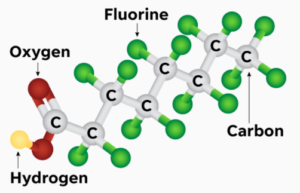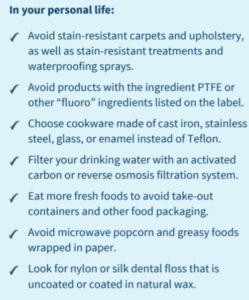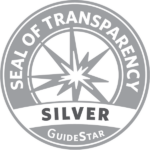PFAS chemicals seem to be everywhere these days: at the top of Mount Everest, in umbilical cord blood, in breast milk, and in the news. In 2022, the U.S. Environmental Protection Agency announced new health advisories for PFAS in drinking water. My Green Doctor explains why PFAS are important and how your patients can avoid them.
breast milk, and in the news. In 2022, the U.S. Environmental Protection Agency announced new health advisories for PFAS in drinking water. My Green Doctor explains why PFAS are important and how your patients can avoid them.
PFAS is an acronym for the chemical group Per- and PolyFluoroAlkyl Substances. The first was invented in 1938. A few have been banned or are being phased out in the European Union or the United States but several hundred PFAS are being manufactured currently. These molecules are both water and oil repellent, making them useful in products such as microwave popcorn bags and pizza boxes; as stain repellents on carpets, furniture, and clothing; for non- stick cookware; in cosmetics and sealants; in many construction materials that are in our homes and offices; and as firefighting foam. Annual U.S. sales of PFAS as stain repellents alone is over $1 billion.
stick cookware; in cosmetics and sealants; in many construction materials that are in our homes and offices; and as firefighting foam. Annual U.S. sales of PFAS as stain repellents alone is over $1 billion.
Unfortunately, global environmental contamination has resulted over the decades as the result of PFAS being discharged in industrial air emissions, released from products in our homes, from sewage treatment plants, from municipal landfills, and from firefighting operations. PFAS are found in all 50 US states in lakes, streams, and groundwater. They are common in our drinking water and in some of the foods we eat. PFAS are in the blood of people globally, including 99% of Americans.
These molecules are toxic. Thousands of peer-reviewed research articles link PFAS to health effects that include kidney and testicular cancer, thyroid disease, liver damage, decreased infant fetal growth, pregnancy-induced hypertension (including pre-eclampsia), dyslipidemia (children & adults), ulcerative colitis, and immune dysfunction (vaccine unresponsiveness). Clinicians need to be alert for these conditions in individuals with high PFAS exposure.
In June 2022, the US EPA set new drinking water health advisory limits for two major PFAS: PFOA and  PFOS. The new safety limits are 3,500-17,500 times lower than the 2016 advisory levels! The new limits are derived from studies of how PFAS impair immune responses in children. These safety levels are so low that few commercial water testing companies can measure them. Municipalities nationwide are scrambling to test their water and make the data available to the public.
PFOS. The new safety limits are 3,500-17,500 times lower than the 2016 advisory levels! The new limits are derived from studies of how PFAS impair immune responses in children. These safety levels are so low that few commercial water testing companies can measure them. Municipalities nationwide are scrambling to test their water and make the data available to the public.
Physicians may remember from their college chemistry class that the carbon–fluorine bond is extremely stable. PFAS are sometimes called “forever chemicals” because they do not readily break down in nature and they bioaccumulate in our tissues to augment their toxicity over time.
Most people do not know how to protect themselves from PFAS. Certain jobs are high risk for exposure:  firefighters, fluorochemical industry workers, those in the carpet industry, and those in the military. These workers should be counseled to seek advice from their workplace’s occupational safety experts.
firefighters, fluorochemical industry workers, those in the carpet industry, and those in the military. These workers should be counseled to seek advice from their workplace’s occupational safety experts.
Health professionals can tell their patients other steps to take (see table). Drinking water is how most people are exposed. All types of water filters remove PFAS but reverse osmosis filters are the best. Bottled water is not an answer because some bottled water has very high PFAS levels and water companies are not required to test their products. Choosing “organic” or “natural” foods has not been shown to help.
If your community water supplies contain PFAS levels above the new EPA advisory, or if there are fluorochemical industries in your area, your patients should drink filtered water and avoid eating local wild game, locally caught fish, and local dairy products. PFAS is found in breast milk but also in the water used to mix infant formula so there are no recommendations against breast feeding.
Look for labels saying PFAS-free or “certified non-toxic.”
Consumers should only buy microwavable popcorn that uses PFAS-free packaging because of the risk of PFAS contamination from popcorn bags. They should buy fast-food and takeout foods only from restaurants that have announced, as some have, that they use only PFAS-free wrappers and containers.
Certain products are particularly worth avoiding: clothing with waterproofing (including Gore-Tex), certain non-stick cookware (including Teflon), clothing treated with waterproofing chemicals (such as Scotch Gard), and carpets and furniture with stain repellents. Many cosmetics contain these toxic chemicals. Look for labels saying PFAS-free or “certified non-toxic”.
Health professionals and consumers can ask governments to fund more research on the health effects of PFAS, to perform more testing of food and water, and to require that PFAS chemicals be displayed prominently on product labels. We all can ask manufacturers and stores to “get the PFAS out”!
About the Authors:
 D.M. Axelrad, PhD is a retired Professor of Environmental Health and environmental toxicologist at Florida A&M University, Tallahassee, Florida, USA. He serves on the Board of Directors of the Florida Chapter of Physicians for Social Responsibility. His email address is [email protected].
D.M. Axelrad, PhD is a retired Professor of Environmental Health and environmental toxicologist at Florida A&M University, Tallahassee, Florida, USA. He serves on the Board of Directors of the Florida Chapter of Physicians for Social Responsibility. His email address is [email protected].
 Todd L Sack MD FACP is Executive Director of the My Green Doctor Foundation. His email address is [email protected].
Todd L Sack MD FACP is Executive Director of the My Green Doctor Foundation. His email address is [email protected].
Further Resources:
1. PFAS in food: https://www.fda.gov/food/chemical-contaminants-food/questions-and-answers-pfas-food Accessed 11.6.2022
2. Human exposure & health effects: https://pubmed.ncbi.nlm.nih.gov/30470793/ Accessed 11.6.2022
3. Understanding the new drinking water advisory: https://pubmed.ncbi.nlm.nih.gov/23597293/ Accessed 11.6.2022
4. Human toxicity: https://www.atsdr.cdc.gov/pfas/health-effects/index.html Accessed 11.6.2022
5. “Guidance on PFAS Exposure, Testing, and Clinical Follow-Up (2022)”, U.S. National Academy of Sciences, http://nap.nationalacademies.org/26156 p 111-112.
Image Credits:
1. Logo: Copyright Florida Medical Association, with permission.
2. PFAS model: https://www.freep.com/story/news/local/michigan/2019/05/31/pfas-contamination-forever-chemical/3770012002/
3. Family: US Department of Agriculture 2021
4. Table: https://pfas-exchange.org/how-to-reduce-your-exposure-to-pfas






Leave a Reply
You must be logged in to post a comment.